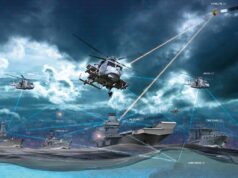The UK has signed up for a further six F-35B Lightning aircraft, in addition to the four already contracted last year. The UK is expected to order 48 as part of a first batch.
The six new F-35Bs form part of the Lot 9 production contract. The UK had ordered its first four operational aircraft as part of the Lot 8 production contract announced in November last year. Industry expects the UK will acquire around 90 of the type.
Although the UK’s planning assumption remains at 138 aircraft, the government is set to announce its requirement in the Strategic Defence and Security Review planned for later this month, it has been rumoured that 48 will be the first batch with numbers increasing in following SDSR’s.
The F-35B will be flown as a common fleet along the lines of the now deactivated Joint Force Harrier. The first squadron will stand up in 2016 in the US and will be 617 squadron who will then transfer to RAF Marham in the UK in 2018.
The F-35 programme is often labelled a “trillion-dollar black hole”, the man in charge of the project vehemently disagrees and lays to rest any fears over rising costs.
Lt. Gen. Chris Bogdan, the head of the F-35 joint program office, hosted a press event with reporters in defence of the programme, citing constant drops in the cost of the jet.
“It is a fact this program is over budget from 2001’s baseline. It’s just true. We will never underrun that number. We will never save that money. It’s gone. What matters is since that time, what’s happened to the cost on the program? It’s gone down, not gone up. Judge the program today, not where it’s been, but where it is and where it’s going.”
Bogdan also pointed out that this year’s selected acquisition report (SAR) noted reducing procurement costs, down by $3 billion. The report can be found here if you wish to verify this information.
The average cost-per-unit in low-rate initial production lots six, seven and eight, the last three lots on contract, have fallen. The below figures also include engines and adjust for inflation.
- F-35A conventional takeoff and landing model: $117 million, $112 million, $108 million.
- F-35B “jump-jet” model: $145 million, $137 million, $134 million.
- F-35C carrier variant: $134 million, $130 million, $129 million.
The F-35 Joint Program Office (JPO) commented:
“Affordability is the number one priority for the F-35 program and this year’s report reflects another year with significant cost reductions and we’re not stopping there. We will continue to drive costs out of the program. The F-35 Joint Program Office has a disciplined approach to analyzing and reducing sustainment costs. Ongoing activities include conducting a sustainment business case analysis and operating a cost war room to find program savings and attack operational, sustainment and total ownership costs.
F-35 unit recurring flyaway costs have been going down with each successive lot of aircraft. Lockheed Martin and Pratt & Whitney have track records for delivering the airframe and engine below government SAR estimates and we expect this trend to continue in the future.”
The Ministry of Defence have clarified the details surrounding the Queen Elizabeth class aircraft carriers and their complement of F-35B aircraft, no doubt in response to the plethora of claims that the vessels will sail with “no aircraft”, “no crew”, no sandwiches in the galley etc.
The following is a direct quote from the MoD that explains the timetable for the UK’s carrier and F-35 projects and can be found here.
There has been speculation in the media that there has been a change in the delivery programme for the F-35B that may result in delays to the roll out of the UK’s Carrier Strike capability – and that, in an operational emergency, US jets may fly from the Carriers until the UK F-35 fleet is ready.
- This is not the case. It was always the intention to take a phased approach to ordering F35.
- We are fully committed to both the F35 and the Queen Elizabeth Carrier programmes -both of which are on track to enter initial maritime operating capability in December 2020 as planned.
- We expect Queen Elizabeth carrier to commence sea trials in 2017, and have been clear that UK F35 aircraft will be used for first of class flying trials in 2018.
- Our relationship with the US is mutually beneficial and we share a sense of common purpose. In 2012 we signed an agreement to enhance cooperation on carrier operations. Indeed, UK pilots have already flown from US ships in preparation for UK carrier operations.
Tabloids often like to quote 12 as the maximum number of F-35B’s the carrier will be able to carry, however this, as you probably know, is nonsense. The carriers, in peacetime, will usually deploy with 12 F-35B’s as a minimum and a number of various helicopters. To reduce costs and free aircraft for other commitments, the maximum aircraft complement will not usually be carried in peacetime, it instead will be supplied as required or deployed to the vessels in the event of a crisis. Rather than funding a large and permanent Carrier Air Group, the relatively new concept of a Tailored Air Group rather than fixed Carrier Air Group will be adopted for the Queen Elizabeth class with the exact types and numbers of aircraft embarked being adjusted to meet current requirements and threats. I don’t see there being much call for 36 F-35B’s if delivering humanitarian aid, do you?
The Queen Elizabeth class mark a change from expressing carrier power in terms of number of aircraft carried, to the number of sortie’s that can be generated from the deck. The class are not the largest class of carrier in the world but they are most likely the smallest and least expensive carrier the Royal Navy could build which still have the advantages that large carriers offer.
Crew move aboard the supercarrier in May 2016, sea trials begin in August 2016 and the vessel moves to Portsmouth in 2017.












Australia has ordered 72!!
So?
Who cares about quantity, quality is what our armed forces are about.
If it turns out to be good order more..
Joe Australia must have more tokens than uk. Six what a pity uk are being left behind in almost every area. Mind you that leaves more money for refugees.
Or, what’s more likely, the UK is ordering in phases to keep costs down.
I would say that by the time they order 20 the price will have risen
Not really, the price is dropping.
Why don’t you just throw in a little bit of casual bigotry about refugees Paul Twitchett?
Oh, you did already.
Ok my friend. Who are these refugees? why are they heading for Europe? Why has not one Muslim country offered to take any? Why have we got soldiers homeless on the streets, why are elderly not being looked after by the country they paid tax and Ni insurance contributions to for all their working lives? The answer is we give it to countries and people who despise us. I’m no bigot my friend never have been and never will be. Open your eyes.
Paul, Saudi Arabia has taken approximately 500,000 Refugees but due to the fact that they have not signed the UN Convention of Human Rights they are not classed as Refugees, Jordan has taken approximately 1.3 million Refugees which has increased its population by more than 25%.
Most of the Arab States in the region of Syria and Iraq are already quite unstable and increasing the number on Sunni or Shia Muslims may tip the balance in ones favour goading a party such as Hezbollah into violence as is their norm.
They’re not suitable right now.
We are.
Also, what does this have to do with F35B’s?
Whilst I agree with not chucking lots of money at a fighter until its proven to actually work, I assume we will pay more in the long run by constantly placing small orders rather than one or two bigger orders. I think we can reasonably assume that the US will throw money at the problem if they don’t work, as they have more invested in the issue than anyone else.
Don’t do it UK, it’s a bloody trap!
Sorry?
You aren’t Canada!
What are you talking about? The F-35B is of significant value to UK industry and is an incredible aircraft according to people with first hand experience.
It probably is and probably is a great aircraft, I’ve seen a lot of positive things about the F-35 but cmon.. look at it.. it will break, not if, but when..
Nathan, not sure if that’s a serious comment?
I don’t even think this whole thing is to be honest
Ok, thanks for the input.
Thank you Australia 🙂
As the only other tier 1 co-developer of the F35. Britain get between 18 and 32% of every sale.
British industry produces that much of this advanced fighter you see.
Recent orders have more than paid for our F35’s and going forward I can only see this continuing.
Between our involvement in Typhoon, Grippen and F35, we pretty much have the fighter market cornered, if you looking for something advanced anyway.
Good news.
Beno
I find it astounding that we have a UK government who still consider that they can still ‘do’ defence on the cheap. History clearly demonstrates that these people are not fit for purpose.
My personal view is that theire are better platforms out there that are more capable than the F35. Unfortunately, if the UK found itself in a protracted campaign, quantity would be required. Maybe we should have a better mix of Typhoon, Gripen and/or Hornet and Rafale!!
The most pressing requirement for the UK at the moment is in a capable maritime defence aircraft. Our security is currently compromised with the Russians gathering vital information on our not so capable nuclear deterrent.
This government needs to re-evaluate the aid budget which will be bigger than the defence budget at some time in the near future.
National Service for all Politicians!!!!!
“If anybody ever tells you anything about an aeroplane which is so bloody complicated you can’t understand it, take it from me: it’s all balls.”
This is one of the causes of concern for many. This plane is having to be explained and justified due to its flying capability not being seen to be good enough by the “Old-School”. The question for all of us is, will it be “good”, of course it is an improvement for the UK over the Harrier. Indeed I believe the B is the base option out of the three variants as the others appear to not meet or exceed other airsystems capability. But the B exceeds the Harrier in performance by a large degree. The only concern is, does the cost justify a plane which is an improvement, but still basically a Harrier Variant ?